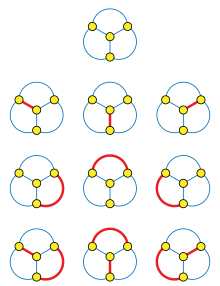
In mathematics, the telephone numbers or the involution numbers form a sequence of integers that count the ways n people can be connected by person-to-person telephone calls. These numbers also describe the number of matchings (the Hosoya index) of a complete graph on n vertices, the number of permutations on n elements that are involutions, the sum of absolute values of coefficients of the Hermite polynomials, the number of standard Young tableaux with n cells, and the sum of the degrees of the irreducible representations of the symmetric group. Involution numbers were first studied in 1800 by Heinrich August Rothe, who gave a recurrence equation by which they may be calculated,[1] giving the values (starting from n = 0)
- ^ Knuth, Donald E. (1973), The Art of Computer Programming, Volume 3: Sorting and Searching, Reading, Mass.: Addison-Wesley, pp. 65–67, MR 0445948
